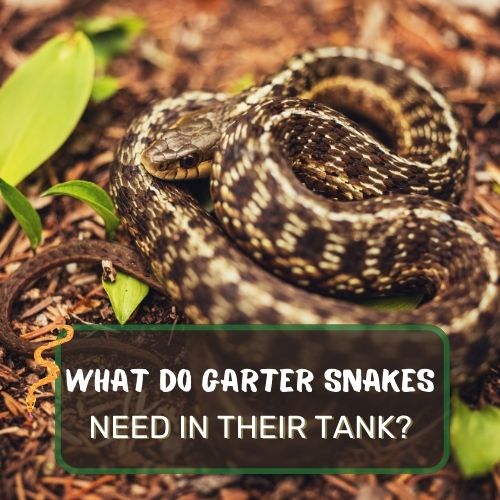Garter snakes, with their vibrant patterns and active nature, have become a favorite among reptile enthusiasts. But, like all pets, they come with their own set of care requirements.
Yes, garter snakes do need a heat lamp. Being ectothermic, they rely on external sources for warmth. A heat lamp provides the necessary basking temperatures, aiding in digestion and overall well-being. It’s essential to ensure the right temperature gradient in their enclosure for optimal health.
In this article, we’ll delve deep into the world of garter snake care, focusing on their lighting, temperature, and humidity needs.
From the significance of UVB lamps to the ideal nighttime temperatures, we’ve covered it all. We’ve even tackled some of the most frequently asked questions to ensure your slithery friend thrives in its new home.
Dive in and discover the ins and outs of garter snake care!

Table of Contents
Lighting and UVB Needs
When it comes to keeping them as pets, one question often pops up: “Do garter snakes need a heat lamp?” Let’s dive into this topic and shed some light (pun intended) on their lighting and UVB needs.
The significance of UVB for garter snakes
Imagine you’re a garter snake, basking under the sun, soaking up all that natural goodness. In the wild, garter snakes are exposed to sunlight, which provides them with essential UVB rays.
These rays play a pivotal role in their health. In captivity, replicating this natural exposure becomes crucial.
Why, you ask?
Well, UVB helps in the synthesis of vitamin D3, which in turn aids in calcium absorption, ensuring strong bones and preventing metabolic bone disease.
Benefits of UVB: vitamin D, appetite stimulation, and overall health
Beyond bone health, UVB has other perks for our slithery friends. Ever noticed how you feel more energetic and hungry on a sunny day? Garter snakes are no different. UVB exposure can stimulate their appetite, making them more active and eager to eat.
It’s like their version of a morning coffee! Moreover, regular UVB exposure contributes to their overall well-being, making them healthier and more vibrant.
Recommended UVB bulbs and distances
Now, not all UVB bulbs are created equal. For garter snakes, certain bulbs are more effective than others.
For instance, the “Zoo Med T8 Reptisun 5.0” is recommended to be placed 4-6” away from the mesh, while the “Arcadia T5 HO Forest 6%” works best at 9-11” through mesh. It’s essential to ensure the right distance to avoid overexposure.
UVB bulb maintenance and replacement
Just like how our favorite pair of sunglasses might eventually wear out, UVB bulbs too have a lifespan. They need to be replaced regularly, typically every 12 months, to maintain their efficiency.
Over time, even if they’re still emitting light, the UVB output can decrease, making them less effective. So, mark your calendar or set a reminder to check and replace the bulb when needed.

Temperature and Basking Needs
Alright, let’s turn up the heat a bit and talk about temperature! Garter snakes, like all reptiles, are ectothermic. This means they can’t regulate their body temperature internally like us warm-blooded mammals.
Instead, they rely on their environment. So, if you’re planning to host one of these cool creatures, understanding their temperature needs is paramount.
Importance of temperature gradient for ectothermic animals
Imagine wearing a winter jacket on a hot summer day and not being able to take it off. Sounds uncomfortable, right? Similarly, garter snakes need a range of temperatures in their enclosure to feel comfortable.
This range, known as a temperature gradient, allows them to move between warmer and cooler areas, regulating their body temperature as needed. It’s like giving them the choice between sunbathing and chilling in the shade.
Recommended basking surface temperatures
For our sun-loving garter snakes, a basking spot is like a mini-vacation spot. It’s where they soak up warmth and digest their food. The ideal basking surface temperature for garter snakes is between 85°F to 90°F.
This ensures they get the warmth they need without overheating.
Cool side temperature range
On the flip side (literally), the cooler end of their enclosure should hover around 70°F to 75°F. This gives them a refreshing spot to retreat to if they feel too warm.
Heating methods and equipment recommendations
Now, achieving this perfect temperature gradient might sound tricky, but with the right equipment, it’s a breeze. Under-tank heaters, ceramic heat emitters, and basking bulbs are all great choices.
Remember to always use a thermostat to regulate the heat and avoid any hot spots that could harm your snake.

Humidity and Hydration
Moving on to another crucial aspect: humidity. Just like us, garter snakes love a bit of spa-like treatment, and maintaining the right humidity levels is a big part of that.
Humidity range for garter snakes
Garter snakes thrive in a humidity range of 50% to 70%. This level mimics their natural habitat and keeps them hydrated and happy.
Importance of a humid hide
Ever heard of a humid hide? It’s like a mini steam room for your snake. A humid hide is a secluded spot in the enclosure with higher humidity, perfect for shedding and relaxation.
It’s a must-have for ensuring your garter snake has a smooth shedding process.
Tips for maintaining optimal humidity levels
Achieving the right humidity can be a balancing act. Here are some tips:
- Use a hygrometer to monitor levels.
- Opt for moisture-retaining substrates like coconut coir or cypress mulch.
- Mist the enclosure lightly with water, but avoid making it too wet.
- Place a large water dish in the enclosure, which can also aid in raising humidity.
Remember, just like us, garter snakes want to feel comfortable in their homes. By ensuring the right temperature and humidity levels, you’re setting them up for a life of comfort and contentment.

Potential Dangers of a UVB Lamp
Let’s face it; while UVB lamps are a godsend for our scaly pals, they come with their own set of challenges. It’s like sunbathing; a little can give you a lovely tan, but too much can lead to a nasty sunburn.
Similarly, while UVB lamps are essential for garter snakes, they can pose potential dangers if not used correctly.
Overexposure to UVB
Just as we can get sunburned after too much time in the sun, garter snakes can suffer from overexposure to UVB. This can lead to skin issues and even eye damage. It’s crucial to ensure the lamp isn’t too close to the snake and that there’s a proper gradient of light.
Faulty or Cheap Equipment
Not all UVB lamps are created equal. Some cheaper or faulty models might emit inconsistent or harmful levels of UVB. Always opt for reputable brands and regularly check the lamp’s functionality.
Overheating
UVB lamps produce heat. If placed too close to the basking spot, it can cause temperatures to soar, leading to potential burns or overheating for the snake.
How to Install a UVB Light
Setting up a UVB light might seem daunting, but with the right steps, it’s as easy as pie. Here’s a step-by-step guide to light up your garter snake’s world:
Choose the Right Bulb
First things first, pick a high-quality UVB bulb suitable for garter snakes. Remember, quality matters!
Positioning is Key
The lamp should be placed at a distance where the snake can benefit from the UVB without the risk of overheating or overexposure. Typically, this is a few inches away, but always refer to the bulb’s guidelines.
Use a Reflective Hood
A reflective hood can help direct the UVB rays downwards, ensuring maximum exposure and preventing any wastage of light.
Connect to a Timer
Garter snakes don’t need 24/7 UVB. Connect the lamp to a timer to replicate a natural day-night cycle. Typically, 10-12 hours of light during the day should suffice.
Regular Maintenance
Lastly, remember to replace the bulb every 12 months and regularly check for any signs of wear or damage.
Installing a UVB light might require a bit of effort initially, but think of it as setting up a cozy reading nook for your snake. With the right light, you’re ensuring they get all the warmth and health benefits they need.
Summary
You’ve journeyed through the essentials of garter snake care, understanding the importance of UVB lighting, temperature gradients, and humidity levels.
Remember, every detail, from the right bulb to the perfect nighttime temperature, contributes to your snake’s well-being. As you embark on this rewarding journey of reptile care, always prioritize your snake’s comfort and health.
With the knowledge you’ve gained, you’re well-equipped to provide the best home for your slithery friend. Keep learning, stay curious, and here’s to many joyful moments with your garter snake!
FAQ
Let’s tackle some of these burning questions (pun intended) head-on:
Do garter snakes need a heat lamp at night?
Nope! Garter snakes, like most reptiles, follow a day-night cycle. While they bask during the day, nighttime is their cool-down period. So, you can turn off that heat lamp when the sun goes down. It gives them a chance to experience a natural drop in temperature, just like in the wild.
Does a garter snake need a heat pad?
Absolutely! A heat pad, especially an under-tank heater, can be a fantastic way to provide consistent warmth. It ensures the snake has a warm spot to digest its food and relax. Just remember to regulate it with a thermostat to avoid overheating.
What temperature do garter snakes like at night?
During the night, garter snakes prefer cooler temperatures, typically around 65°F to 75°F. It’s a bit like us snuggling under a blanket in cooler weather. This drop in temperature is essential for their metabolism and overall well-being.




0 Comments